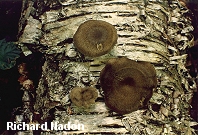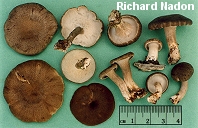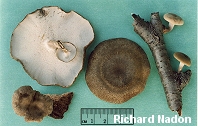| Major Groups > Polypores > Stemmed, Pale-Fleshed > Polyporus brumalis |

|
Polyporus brumalis [ Basidiomycota > Polyporales > Polyporaceae > Polyporus . . . ] by Michael Kuo This small, dark brown polypore distinguishes itself from similar species by having a stem which does not become black, a smooth (rather than hairy) cap margin, and tiny circular pores. It fruits on the deadwood of hardwoods, and has a special affinity for birch. The tough fruiting bodies are persistent and can be found year-round, but it tends to come up fresh in fall and spring. Polyporus arcularius is very similar, but features a cap margin that is fringed with tiny hairs, and a paler cap surface. Thanks to the Field Museum of Natural History for facilitating study of the collections cited below. Description: Ecology: Saprobic on decaying wood of hardwoods and especially frequent on dead birch wood; growing alone or gregariously; fall and spring, but found nearly year-round; widely distributed in North America. The illustrated and described collections are from Québec, Illinois, and Michigan. Cap: 2–8 cm; broadly convex with a tucked-under margin at first; becoming flat, or shallowly depressed; round in outline; dry; bald or very finely hairy; dark yellowish brown to dark brown. Pore Surface: Running slightly down the stem; white; not bruising; with 2–3 round pores per mm; tubes to 3 mm deep. Stem: Central or somewhat off-center; 2–4 cm long; 2–5 mm wide; equal; dry; bald or finely hairy; whitish to grayish or pale brownish; tough. Flesh: Whitish; thin; very tough. Spore Print: White.Microscopic Features: Spores 6–7 x 1–1.5 µm; cylindric; smooth; hyaline in KOH. Hymenial cystidia not found. Hyphal system dimitic. Clamp connections present. REFERENCES: (Persoon, 1794) Fries, 1818. (Fries, 1821; Saccardo, 1888; Overholts, 1953; Smith, Smith & Weber, 1981; Gilbertson & Ryvarden, 1986; Phillips, 1991/2005; Kruger, 2002; Lincoff, 1992; Nunez & Ryvarden, 1995; Barron, 1999; Roody, 2003; McNeil, 2006; Binion et al., 2008; Sotome et al., 2008.) Herb. F 1116132, 1116133, 1188572. This site contains no information about the edibility or toxicity of mushrooms. |
© MushroomExpert.Com |
|
Cite this page as: Kuo, M. (2015, May). Polyporus brumalis. Retrieved from the MushroomExpert.Com Web site: http://www.mushroomexpert.com/polyporus_brumalis.html |


